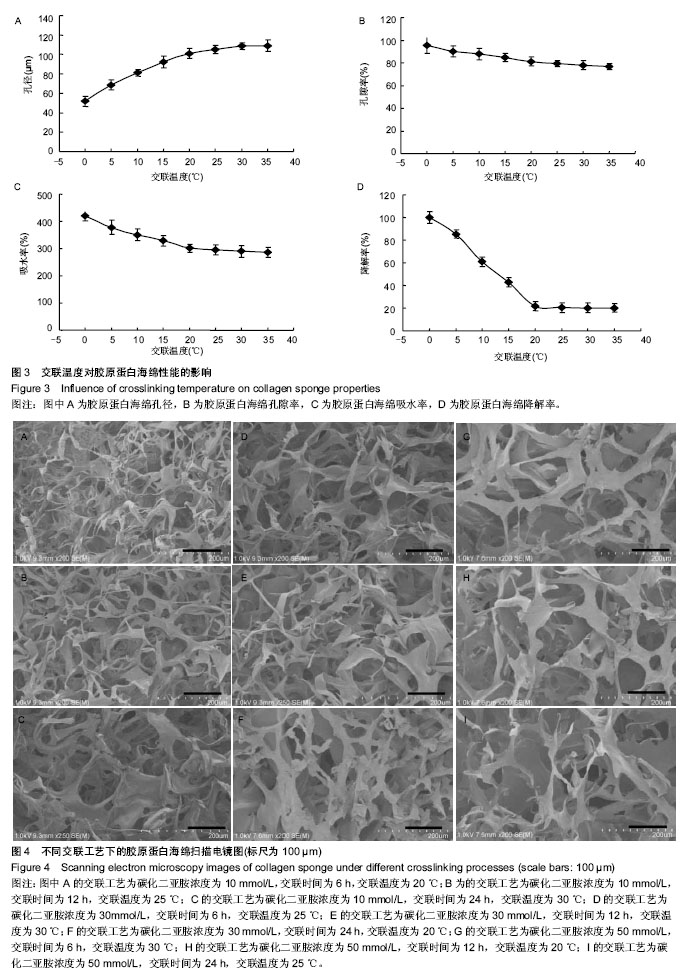| [1] Murphy CM,Matsiko A,Haugh MG,et al.Mesenchymal stem cell fate is regulated by the composition and mechanical properties of collagen-glycosaminoglycan scaffolds. J MechBehav Biomed Mater.2012;11:53-62.
[2] 刘辉辉,郭善禹.皮肤组织损伤修复的研究进展[J].外科理论与实践,2013,18(2):188-192.
[3] 高长有,马列.医用高分子材料[M].北京:化学工业出版社, 2006: 22-26.
[4] 付小兵,吴志谷.现代创伤敷料理论与实践[M].北京:化学工业出版社,2007:149.
[5] Gelse K,Poschl E,Aigner T. Collagens-structure,function,and biosynthesis. Adv Drug Deliv Rev.2003;55(12):1531-1546.
[6] 李贺,郑庚修,王秋芬,等.生物医学材料胶原蛋白的研究进展(II)胶原的性质及其在生物医学领域的应用[J].中国皮革, 2006, 35(3):27-31.
[7] Madhumathi K,Sudheesh Kumar PT,Abhilash S,et al.Development of novel chitin/ nano-silver composite scaffolds for wound dressing applications.J Mater Sci Mater Med.2010;21(2):807-813.
[8] 邱敏梅,易石坚,何大源,等.医用胶原蛋白海绵治疗重度肝破裂的临床研究[J].中国医药导报,2006,3(23):36-38.
[9] Liu T,Teng WK,Chan BP,et al. Photochemical crosslinked electrospun collagen nanofibers: Synthesis, characterization and neural stem cell interactions. J Biomed Mater Res A. 2010;95(1):276-282.
[10] 俞振立,黄新妍.胶原蛋白海绵在甲状腺手术中的应用[J].中国眼耳鼻喉科杂志,2013,13(5):318-319.
[11] Murphy CM,Matsiko A,Haugh MG,et al.Mesenchymal stem cell fate is regulated by the composition and mechanical properties of collagen-glycosaminoglycan scaffolds. J Mech Behav Biomed Mater.2012;11:53-62.
[12] 王会学.局部植入治疗骨与关节结核药物缓释体的制备与特性研究[D].第二军医大学博士学位论文,2011.
[13] 迟妍妍,乐尧金,刘旭昭,等.胶原蛋白海绵的生物特性及体内降解吸收[J].中国组织工程研究,2014,18(34):5515-5519.
[14] 王碧,王坤余,叶勇,等.胶原材料在药物缓释和组织工程中的研究进展[J].中国修复重建外科杂志,2004,18(2):112-114.
[15] 颜文龙,孙恩杰,郭海英,等.组织工程支架材料[J].上海生物医学工程,2004, 25(1):51-54.
[16] Park SN,Park JC,Kim HO,et al.Characterization of porous collagen/hyaluronic acid scaffold modified by 1-ethyl-3-(3-dimethylaminopropyl) carbodiimide crosslinking. Biomaterials.2002;(23):1205-1212.
[17] Gao CY,Ma L.Medical polymer materials. Beijing: Chemical Industry Press, 2006:22-26.
[18] Usha R,Sreeram KJ,Rajaram A.Stabilization of collagen with EDC/NHS in the presence of L-lysine: a comprehensive study.Colloids Surf B Biointerfaces. 2012;90:83-90.
[19] 徐新宇.胶原的提取、改性、交联及其应用[J].透析与人工器官, 2004,15(4):38-46.
[20] 但年华,但卫华,曾睿,等.碳化二亚胺改性脱细胞猪真皮基质的性能研究[J].功能材料,2007,38(8):1389-1392.
[21] Wissink MJ,Beernink R,Poot AA,et al.Improved endothelialization of vascular grafts by local release of growth factor from heparinized collagen matrices.J Control Release. 2000;64(1-3):103-114.
[22] Peter A,Jochen A,Richard K,et al.Influence of different collagen species on physical&chemical properties of crosslinked collagen matrices.Biomaterials.2004; 25: 2831-2841.
[23] 徐新宇,顾汉卿.组织工程应用的胶原蛋白的制备和改性研究[D].天津医科大学硕士学位论文,2005.
[24] 秦胜男,陈鸿辉,杨小红,等.经碳化二亚胺/N-羟基琥珀酰亚胺交联的Ⅱ型胶原海绵的制备[J].中国矫形外科杂志,2010,18(12): 1014-1018.
[25] 琚海燕,王坤余,苏德强,等.碳化二亚胺改性胶原纤维支架材料的特性表征[J].功能材料,2009,40(1):116-118.
[26] 谢德明,施云峰.胶原支架材料的制备与表征[J].暨南大学学报, 2006,26(3):339-443. |


